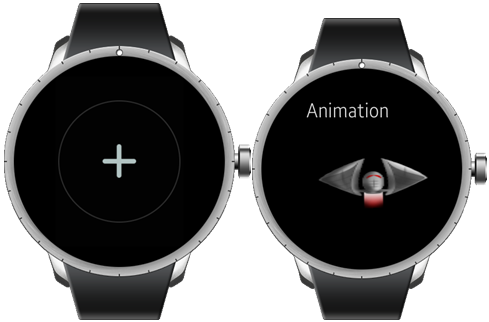
Widget Animation Sample Overview
The Widget Animation sample demonstrates how you can use an animation in your widget application to show a simple image rotation.
The following figure illustrates the main view of the Widget Animation application.
Figure: Widget Animation main view

Implementation
To implement the Widget Animation application:
- Create a widget application by calling the widget_app_main() function in the main function. You can register the widget application life-cycle callbacks when you call the widget_app_main() function.
widget_app_lifecycle_callback_s ops = { 0, }; int ret; ops.create = widget_app_create; ops.terminate = widget_app_terminate; ret = widget_app_main(argc, argv, &ops, NULL); if (ret != WIDGET_ERROR_NONE) { dlog_print(DLOG_ERROR, LOG_TAG, "widget_app_main() is failed. err = %d", ret); } - Create the widget application instance with the widget_app_class_create() function. It adds the widget instance life-cycle callbacks.
static widget_class_h widget_app_create(void *user_data) { widget_instance_lifecycle_callback_s ops = { .create = widget_instance_create, .destroy = widget_instance_destroy, .pause = widget_instance_pause, .resume = widget_instance_resume, .update = widget_instance_update, .resize = widget_instance_resize, }; return widget_app_class_create(ops, user_data); } - Get the widget application instance's window with the widget_app_get_elm_win() function and draw the animation effect:
widget_instance_data_s *wid = (widget_instance_data_s*) malloc(sizeof(widget_instance_data_s)); int ret; // Window ret = widget_app_get_elm_win(context, &wid->win); if (ret != WIDGET_ERROR_NONE) { dlog_print(DLOG_ERROR, LOG_TAG, "failed to get window. err = %d", ret); return WIDGET_ERROR_FAULT; } evas_object_resize(wid->win, w, h); - Add an image to the widget application window:
// Animation wid->ship = evas_object_image_filled_add(evas_object_evas_get(wid->win)); char buf[256]; snprintf(buf, sizeof(buf), "%s/ship.png", app_get_resource_path()); evas_object_image_file_set(wid->ship, buf, NULL); evas_object_resize(wid->ship, SHIP_IMAGE_WIDTH, SHIP_IMAGE_HEIGHT); evas_object_move(wid->ship, 100, 150); evas_object_show(wid->ship);
- Add the animation effect with the ecore_animator_timeline_add() function:
Ecore_Animator *animator = ecore_animator_timeline_add(ANIM_TIME, _do_animation, wid->ship);
